
What Is a 404 Error Code? Common Causes and Fixes
Encountering a 404 Not Found error may be a manageable issue on your site. Yet, it’s undoubtedly frustrating for you and your visitors who stumble upon this dead end while navigating your website. It’s particularly unwelcoming for new potential customers browsing your brand for the first time.
Beyond user experience, a 404 error can signal the need for a fix, such as implementing a 301 redirect to maintain SEO health. This article will guide you through resolving these errors to ensure your site functions smoothly.
What Causes a 404 Error Message?
A 404 Not Found error is a standard HTTP status indicating that the requested resource doesn’t exist on the server. While the error is uniform, the cause can vary. Consider it analogous to a failed search engine query, just as a search engine scans its database for relevant pages. It presents them, a web browser searches for a specific webpage. If that webpage is missing, the browser displays a 404 error.
Now, let’s explore the top five reasons behind this error in the following section.
The URL Does Not Exist
A 404 error typically occurs when a domain or website URL has been mistyped or does not exist. It can be frustrating for users who are searching for specific, valuable information and find themselves at a dead end.
To improve user experience, some site owners customize the 404 error page instead of relying on the default message. For instance, attempting to visit a non-existent page like https://www.example.com/this-page-does-not-exist will trigger the standard 404 error, which displays a plain “Not Found” message along with “The requested URL /this-page-does-not-exist was not found on this server.”
Creating a more welcoming and helpful 404 error page can greatly assist visitors. This enhanced page may include links to the main website, the homepage, a sitemap, or a contact form. It might also showcase other exciting or helpful content from the site, providing options rather than a simple error notification.
The Resource Is either Moved or Deleted.
Web browsers rely on the precise structure of URLs to retrieve pages. If you relocate or delete files, the server will report a 404 error when the resource or file can’t be located at the expected address. Users might encounter this error if they try to reach the content via an outdated URL or a broken link.
Providing a custom 404 error page with clear information can enhance the user experience and mitigate the annoyance of hitting a dead end. By guiding users effectively during such instances, you can decrease bounce rates and boost your site’s SEO performance.
The Server Needs to Be Configured
A 404 error can sometimes arise from server misconfiguration. When a web server isn’t correctly configured to process the URL or resource that’s been requested. In such scenarios, the server fails to serve the desired page, resulting in a 404 error message.
Resolving this issue requires a thorough check of the server’s configuration settings to correct the client-side error and to ensure the right webpage is delivered. Proper server setup and management are crucial to prevent such errors and to maintain a seamless user experience, which in turn can favourably impact search engine rankings.
Broken Links
A broken link can also cause this error. The 404 error occurs if the connection is inaccurately entered, has become outdated, or needs to be corrected, directing users to a non-existent page. Upon discovering any broken links, it’s advisable to update or delete them promptly.
You can locate such broken links by employing a broken link-checking tool or by manually reviewing the links on your website. Consistently monitoring and fixing broken links is essential for delivering an optimal user experience and preventing 404 errors. Maintaining accurate and current links is also vital for enhancing the website’s reliability and gaining user trust.
Access Restrictions
When a user tries to reach a resource they don’t have permission to view, the server blocks access and returns an error message. This measure is in place to stop unauthorized access to specific resources.
Ensuring that access permissions are correctly set is critical, allowing authorized users to reach the necessary resources while keeping unauthorized users out. It’s vital to regularly review and update access controls to maintain the website’s security without impeding user accessibility where it’s permitted.
Why Should You Fix Them?
Firstly, it elevates the user experience. Customized error pages that offer useful links and information help retain visitors to your site.
Secondly, it’s a crucial aspect of SEO health. Search engines and users both prefer to avoid encountering broken pages. A smooth user experience can lead to higher search engine rankings, which is a direct benefit of addressing site errors.
Thirdly, the perceived reliability of your website is at stake. A site riddled with errors can quickly erode its credibility and the trust of its users.
Lastly, consistent site maintenance is crucial to functionality. Regularly monitoring for and fixing broken links and errors is fundamental to ensuring your website operates smoothly, providing a stellar user experience.
What Tools to Use in Finding These Errors
In the previous section, we outlined four fundamental factors: user experience, SEO, website credibility, and website maintenance. These elements are critical to remember for anyone aspiring to thrive in the online business sphere, regardless of their level of expertise.
To efficiently handle 404 errors, employing the right tools can significantly reduce the effort required. For those seeking to prevent 404 errors without resorting to manual checks, consider the following resources:
- Google Search Console offers insights into problematic URLs and guides rectification.
- Screaming Frog is a comprehensive tool that identifies 404 errors on your site, complete with details like page titles and HTTP status codes.
- SEMRush conducts a thorough website audit, pinpointing various issues, including 404 errors, and compiles a list of URLs for you to address.
- Tools such as Ahrefs, Moz, and Broken Link Checker are also available for spotting and fixing broken links.
- For an instantaneous link check on a particular page, Chrome extensions like Check My Links or LinkMiner can be useful. They simplify the process by marking 404 errors with just one click.
With these tools, you can maintain an error-free and seamless website operation.
Fixing the ‘404 Not Found’ Error
It’s a common experience to navigate a website and unexpectedly hit a “404 not found” error page. Beyond the immediate annoyance, this can also doubt the website’s reliability. However, there are established methods to correct this issue. While we’ve touched on these solutions previously, they warrant further attention and emphasis here.
Add Custom Error Pages
Creating a custom error page can effectively mitigate the frustration of encountering a “404 not found” error. It should inform the user that the desired page is unavailable and provide alternative navigation options within the website.
Incorporating elements such as a search bar or a comprehensive navigation menu can assist users in locating their intended content, ensuring they continue their visit with minimal disruption.
Redirect the Broken URL to a Related URL
Addressing a “404 not found” error can also involve identifying and rectifying broken links across your site. These links lead to pages that have either been moved or removed. Clicking on such a link results in the user landing on a 404 error page, different from the content they were looking for.
To prevent this situation, it’s essential to conduct frequent checks for broken links—both internal and external—and repair them promptly. Implementing redirects that guide users from outdated URLs to current, relevant pages can significantly enhance the user experience and improve your site’s SEO ranking.
Fix File Permissions
Improper file permissions might lead the server to deny access to a file or resource, which can trigger a 404 error. Such errors can damage your website’s reputation and lead to user dissatisfaction. Rectifying file permissions involves adjusting settings to allow the server to retrieve and serve the desired content to the user.
Addressing these permission issues is vital for maintaining an uninterrupted and user-friendly experience on your website.
Disable the .Htaccess File
Temporarily deactivating the .htaccess file is also a suggested step. This file holds directives that can occasionally conflict with the server, resulting in a 404 error. Turning off the .htaccess file can help pinpoint the source of the error.
If this resolves the issue, it’s wise to examine the file and fix any directives causing trouble thoroughly. It not only addresses the current error but also allows you to troubleshoot additional issues that may be impacting the website’s performance negatively.
Restore Website Backup
Restoring a previous website backup can effectively resolve 404 errors. Begin by locating a backup from before the errors occurred. Proceed to restore this backup through your web hosting control panel or by using an FTP client.
It’s crucial to follow the instructions closely. After the backup is restored, conduct a thorough review of your website to confirm that the 404 errors have been fixed. If they are not, exploring alternative solutions would be necessary.
How HTTP 404 Errors Damage a Website’s Ranking and Reputation
HTTP 404 errors, signaling that a server cannot find the requested web page, can have several adverse effects on a website’s SEO ranking and credibility.
Initially, they can reduce the user experience and satisfaction, potentially resulting in increased bounce rates and decreased conversion rates.
Furthermore, these errors can impact the efficiency with which search engine bots crawl and index the site, potentially obstructing the visibility and ranking of its pages.
Lastly, 404 errors, particularly those caused by broken links or obsolete content, can harm a website’s perceived authority and trust, which is critical for retaining user trust and maintaining SEO strength.
Engage With the User Through a Custom 404 Error Page
The 404 error, often the subject of internet humor, actually flags a critical issue that demands attention. Neglecting it can escalate to more severe setbacks, like losing website traffic or dropping search engine rankings. Swift identification and error resolution are essential for facilitating a seamless user experience.
Incorporating a well-designed custom 404 error page can transform a potential moment of user frustration into a more delightful interaction. Employing a bit of wit or creative graphics can engage visitors while offering helpful links that guide them back to relevant sections of your site. Such a strategy not only enhances user engagement but can also contribute positively to your website’s image.
Regarding web hosting services, AEserver provides tools and support to manage these issues effectively. AEserver’s platform includes features that allow for easy monitoring and quick fixes to broken links, as well as customization options for error pages. Utilizing such features can be instrumental in keeping your site navigable and maintaining its integrity.



